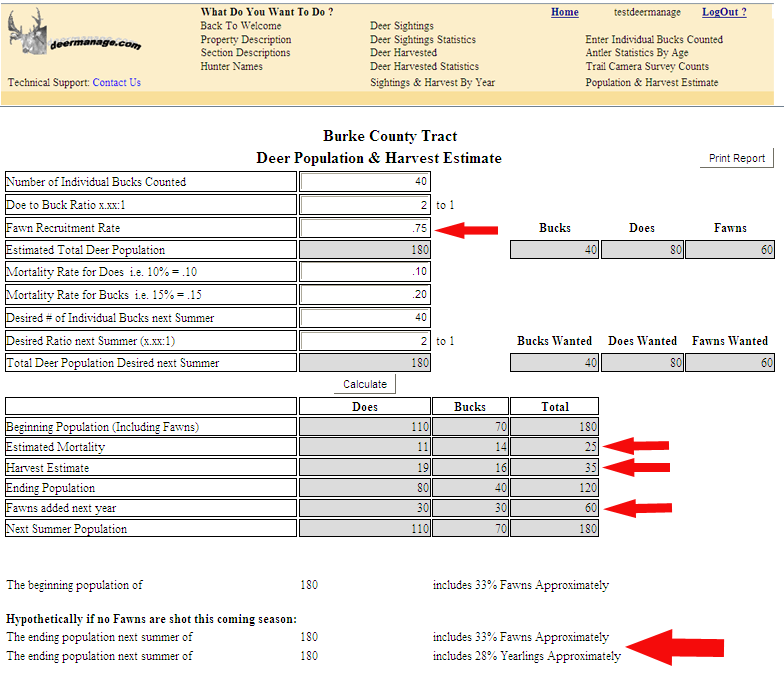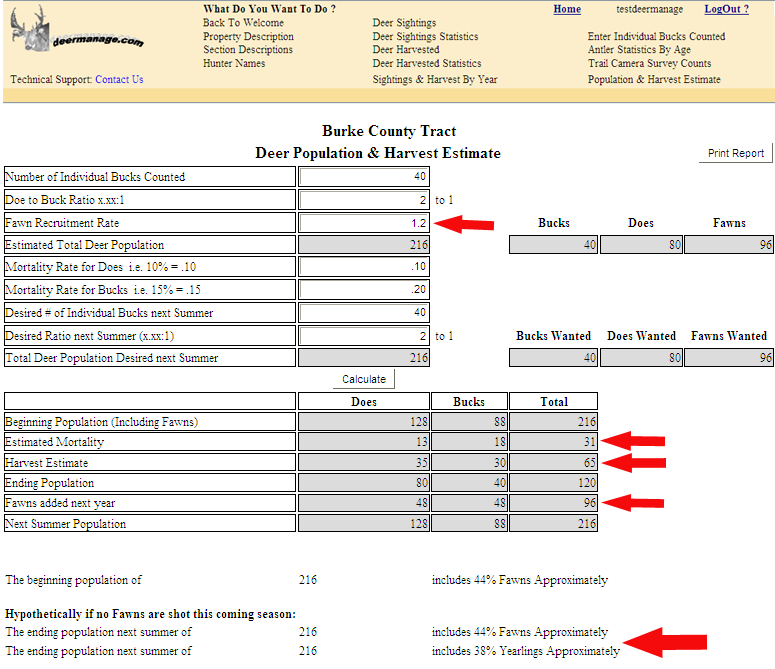In this article I want to show you some of the pros and cons of a low recruitment rate and a high recruitment rate. I will show you some quantitative examples so you can see some actual numbers which will make my point easier to understand. I have found that this visual illustration gives people a much better understanding of how fawn recruitment affects their deer population and more importantly their deer harvest requirements. If you have not done so, please read my article “Knowing your Fawn Recruitment Rate is Important! In that article I explain what fawn recruitment rate is and how you can estimate the fawn recruitment rate on your property or in your area. The point I’m trying to illustrate in this article is how many young (6 month & 1 ½ year old) deer you may have in your deer population and how it can impact your selective harvest. Many hunters try to avoid shooting a 6 month old and a 1 ½ year old deer. (Especially bucks) Some hunt clubs even make it a club rule to not shoot these young bucks which I think is great. That is, unless the dynamics of your own deer population dictate otherwise. Believe it or not there are properties out there that fall into the various scenarios that I illustrate below and everywhere in between.
I will now use my formula for “Deer Population and Harvest Estimate” to illustrate to you how different recruitment rates can drastically affect your deer population and harvest requirements. In each example I am assuming that there are approximately 40 different resident bucks on this property and that there is a Doe to Buck ratio of 2:1. (By resident bucks, I mean bucks that spend most of their time on this property) The size of this property is irrelevant for the purposes of this illustration. It could be a 600 acre tract or a 3000 acre tract. The important thing is that we are intentionally trying to maintain approximately 40 different bucks and approximately a 2:1 Doe to Buck ratio for all three scenarios below.
In this first example I am using a recruitment rate of .40
(Click on pictures to enlarge.)
In the example above we have approximately 40 different resident bucks on this property. With a 2:1 Doe to Buck ratio that gives us approximately 80 does on the property. With a fawn recruitment rate of .40 that will give us approximately 32 fawns for a total estimated deer population of 152 deer. I am trying to keep the deer population the same. I am using a mortality rate of 10% for does and 20% for bucks. (Your rates might be higher or lower) As a result of this we estimate that we will lose approximately 10 does and 11 bucks to natural mortality. (Disease, winter kill, fighting, hit by car, etc.) After this we estimate that we should harvest approximately 6 does and 5 bucks for a total of 11 deer.
Now let’s move on down to the bottom of the estimate form where it says “The ending population next summer of 152 includes 21% fawns and 18% yearlings (1 ½ year old deer) The formula is assuming that no fawns will be shot in the current season. This is saying that 39% of our deer population next season will be fawns and yearlings. So, of the 152 deer approximately 59 deer will be fawns and yearlings and approximately 93 deer will be 2 ½ years old and older. In this example since we are going to harvest 11 deer there are plenty of 2 ½ year old and older deer to harvest.
Pro: You have enough older deer to harvest.
Con: You should only harvest approximately 11 deer. (6 does and 5 bucks) If you have more than 11 hunters then not everyone will be able to shoot a deer.
Now let’s look at the next example.
In this example I am using a recruitment rate of .75
In the example above we still have approximately 40 different resident bucks on this property. With a 2:1 Doe to Buck ratio that gives us approximately 80 does on the property. With a fawn recruitment rate of .75 that will give us approximately 60 fawns for a total estimated deer population of 180 deer. I am trying to keep the deer population the same. I am using a mortality rate of 10% for does and 20% for bucks. As a result of this we estimate that we will lose approximately 11 does and 14 bucks to natural mortality. (Disease, winter kill, fighting, hit by car, etc.) After this we estimate that we should harvest approximately 19 does and 16 bucks for a total of 35 deer.
Now let’s move on down to the bottom of the estimate form where it says “The ending population next summer of 180 includes 33% fawns and 28% yearlings (1 ½ year old deer) This is saying that 61% of our deer population next season will be fawns and yearlings. So, of the 180 deer approximately 110 deer will be fawns and yearlings and approximately 70 deer will be 2 ½ years old and older. In this example since we are going to harvest 35 deer there should be enough 2 ½ year old and older deer to harvest.
Pro: You have enough older deer to harvest but if the older deer do what they do best you may have a hard time harvesting these older deer.
Con: Between harvest and mortality you will lose 60 deer of which many of them come out of the 70 older deer on your property. As a result of this you will have mostly young deer on your property. This happens quite often.
Now let’s look at the next example.
In this example I am using a recruitment rate of 1.20
In the example above we still have approximately 40 different resident bucks on this property. With a 2:1 Doe to Buck ratio that gives us approximately 80 does on the property. With a fawn recruitment rate of 1.20 that will give us approximately 96 fawns for a total estimated deer population of 216 deer. I am trying to keep the deer population the same. I am using a mortality rate of 10% for does and 20% for bucks. As a result of this we estimate that we will lose approximately 13 does and 18 bucks to natural mortality. After this we estimate that we should harvest approximately 35 does and 30 bucks for a total of 65 deer.
Now let’s move on down to the bottom of the estimate form where it says “The ending population next summer of 216 includes 44% fawns and 38% yearlings (1 ½ year old deer) This is saying that 82% of our deer population next season will be fawns and yearlings. So, of the 216 deer approximately 177 deer will be fawns and yearlings and approximately 39 deer will be 2 ½ years old and older. In this example since we need to harvest 65 deer there aren’t enough 2 ½ year old and older deer to harvest which means that you need to harvest some fawns and/or 1 ½ year old deer to meet your harvest requirements.
Pro: You need to shoot a lot of deer. (For many hunters this may not be a good thing because they don’t like to shoot young deer)
Con: You have to shoot some 6 month old and/or 1 ½ year old deer to reach your harvest quota. If you don’t harvest enough deer then overpopulation may become a problem on your property or in your area. Too many deer will mean less healthy deer.
So, the point I’m trying to make is that the dynamics of the deer population on your own property or in your own area can be and probably is different from other properties or areas. (Possibly even areas just a few miles away) By dynamics I am referring to your own recruitment rate, doe to buck ratio, deer density, carrying capacity, mortality rates and your harvest selections. (If it’s brown it’s down or selective harvest) I had a guy ask me how many acres we had and how many deer we shot one season. When I told him the size of our property and how many deer we shot, he said that we probably shot too many deer. He obviously feels that there are a certain number of acres per deer to be shot regardless of our own specific situation. As I illustrated above the harvest requirements can vary tremendously from area to area.
Also, let me point out that I’m not advocating that it’s ok to go out and shoot young deer (especially Bucks). What I am trying to point out is that there are some situations out there where it may be in the best interest of the deer population and your hunting experience to take out a few younger deer. In this particular situation, by taking out some younger bucks it would let some of the older bucks get another year of growth. It’s easy to get caught up in deer management where we set our standards quite high on which deer (especially bucks) that we will harvest or allow to be harvested. If you’re not careful you may find that your deer population is growing but the quality of the deer is declining because you have exceeded your land’s carrying capacity.
In the same token, if you should only be harvesting approximately 6 does and 5 bucks and you shoot 10 does and 9 bucks then eventually you may find your deer population declining way below the carrying capacity of the land. You may have healthier deer but your hunting may become much more difficult and the fun factor may go down.
In summary, I’m sure you’ve heard that old quote “With Knowledge Comes Power”. We should all try to educate ourselves on the dynamics of the deer populations on our own properties and in our own areas. If you have large acreage (1000 acres or more) get started now on keeping some simple records that will help you monitor and manage you own deer population. If you have small acreage then round up some neighbors and let them know how important it is to monitor and manage the deer population in the area that you all share. If they know that your intentions are to maximize the hunting experience in your/their area then they just may work with you in keeping the basic records you need to monitor and manage the deer population that you all share. Even if I was just hunting 50 acres I would still keep my records so that I would know with certainty if my deer sightings and deer harvests are going up or going down from season to season. We do this by using the software that I have made available on our website. When one of our club members talks about our deer sightings or harvests it is based on our actual documented records and not our memories.
Note: With regards to the mortality rate I want to point out the following. By establishing the fawn recruitment rate in the late summer or early fall that rate is excluding fawns that died during the first few weeks of their lives. Thus, the recruitment rate already allows for these early deaths and these deaths are not part of the mortality rate. The mortality rate includes all other deaths for does and bucks (including fawns that may die later in the year)



